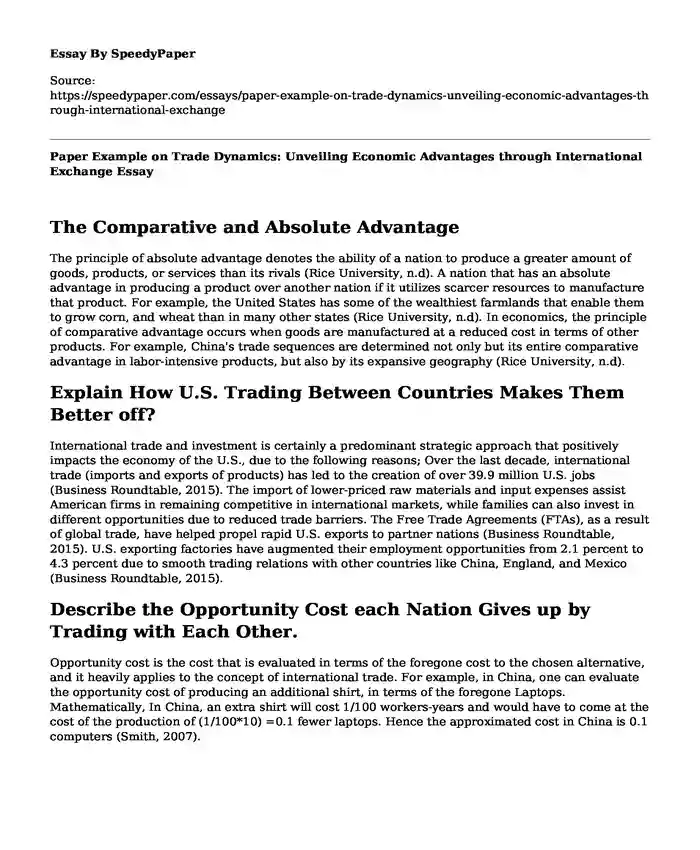
| Type of paper: | Essay |
| Categories: | Economics International relations |
| Pages: | 3 |
| Wordcount: | 732 words |
The Comparative and Absolute Advantage
The principle of absolute advantage denotes the ability of a nation to produce a greater amount of goods, products, or services than its rivals (Rice University, n.d). A nation that has an absolute advantage in producing a product over another nation if it utilizes scarcer resources to manufacture that product. For example, the United States has some of the wealthiest farmlands that enable them to grow corn, and wheat than in many other states (Rice University, n.d). In economics, the principle of comparative advantage occurs when goods are manufactured at a reduced cost in terms of other products. For example, China's trade sequences are determined not only but its entire comparative advantage in labor-intensive products, but also by its expansive geography (Rice University, n.d).
Explain How U.S. Trading Between Countries Makes Them Better off?
International trade and investment is certainly a predominant strategic approach that positively impacts the economy of the U.S., due to the following reasons; Over the last decade, international trade (imports and exports of products) has led to the creation of over 39.9 million U.S. jobs (Business Roundtable, 2015). The import of lower-priced raw materials and input expenses assist American firms in remaining competitive in international markets, while families can also invest in different opportunities due to reduced trade barriers. The Free Trade Agreements (FTAs), as a result of global trade, have helped propel rapid U.S. exports to partner nations (Business Roundtable, 2015). U.S. exporting factories have augmented their employment opportunities from 2.1 percent to 4.3 percent due to smooth trading relations with other countries like China, England, and Mexico (Business Roundtable, 2015).
Describe the Opportunity Cost each Nation Gives up by Trading with Each Other.
Opportunity cost is the cost that is evaluated in terms of the foregone cost to the chosen alternative, and it heavily applies to the concept of international trade. For example, in China, one can evaluate the opportunity cost of producing an additional shirt, in terms of the foregone Laptops. Mathematically, In China, an extra shirt will cost 1/100 workers-years and would have to come at the cost of the production of (1/100*10) =0.1 fewer laptops. Hence the approximated cost in China is 0.1 computers (Smith, 2007).
Does either Country have an Absolute Advantage in Producing Their Goods?
To explain the principle of absolute advantage, we are going to make an assumption on two countries (the United States, and Japan) on the production of two commodities (food and cars), applying labor as the only input. Suppose Japan needs four units to produce food, and U.S. only requires two units (Joslin, n.d). On the other hand, Japan needs six components to manufacture one vehicle, and the U.S. requires nine units to manufacture cars. It can be concluded that Japan has an absolute advantage in the production of cars, and the latter has an absolute advantage in the production of food (corn, and wheat) (Joslin, n.d).
How Does Identifying Each Country's Comparative Advantage Aid Towards Understanding its Benefits in Free Trade?
The U.S. has a comparative advantage in the exportation of agricultural products like corn, soybeans, cotton, and pork products. In 2019, the monetary worth of U.S. exports to China was $107.63 billion. China has a comparative advantage in trade goods like motor vehicle parts, computers, cellphones, etc. The comparative advantage and bilateral financial relationship between the U.S. and China have delivered more benefits to the former. For example, more than 1.8 million job opportunities have been created through U.S. export firms in different sectors (Meltzer & Shenai, 2019). FTAs have been created as a result of the bilateral partnership with China through the “Trans-Pacific Partnership” (TPP) that later the U.S. withdrew from (Meltzer & Shenai, 2019).
References
Business Roundtable. (2015). How the U.S. economy benefits from international trade and investment? Trade partnership. https://tradepartnership.com/wp-content/uploads/2015/01/US_State_Study.pdf
Joslin, T. Absolute advantage. Princeton University Press. http://assets.press.princeton.edu/chapters/s8736.pdf
Meltzer, J. P., & Shenai, N. (2019). The US-China economic relationship: A comprehensive approach. Available at SSRN 3357900. https://www.brookings.edu/wp-content/uploads/2019/02/us_china_economic_relationship.pdf
Rice University. Principles of economics: absolute and comparative advantage. https://opentextbc.ca/principlesofeconomics/chapter/33-1-absolute-and-comparative-advantage/
Smith, T. Prof. (2007). Economics homework on production possibilities, opportunity costs, absolute and comparative advantage. Yale University. http://www.econ.yale.edu/smith/econ116a/ans7116b.pdf
Cite this page
Paper Example on Trade Dynamics: Unveiling Economic Advantages through International Exchange. (2023, Nov 12). Retrieved from https://speedypaper.com/essays/paper-example-on-trade-dynamics-unveiling-economic-advantages-through-international-exchange
Request Removal
If you are the original author of this essay and no longer wish to have it published on the SpeedyPaper website, please click below to request its removal:
- Free Essay Example on Unemployment as a Social Issue
- Essay Sample on Homeland Security - Methodological Approach
- Free Essay Example: Employment Relations
- Essay Example. Java Been Job Aid
- Essay Sample on Wal-Mart v. Dukes: Corporate Accountability and Discrimination in the Workplace
- Intensive Farming of Animals - Free Essay Sample
- Critical Infrastructure - Free Essay Sample
Popular categories




